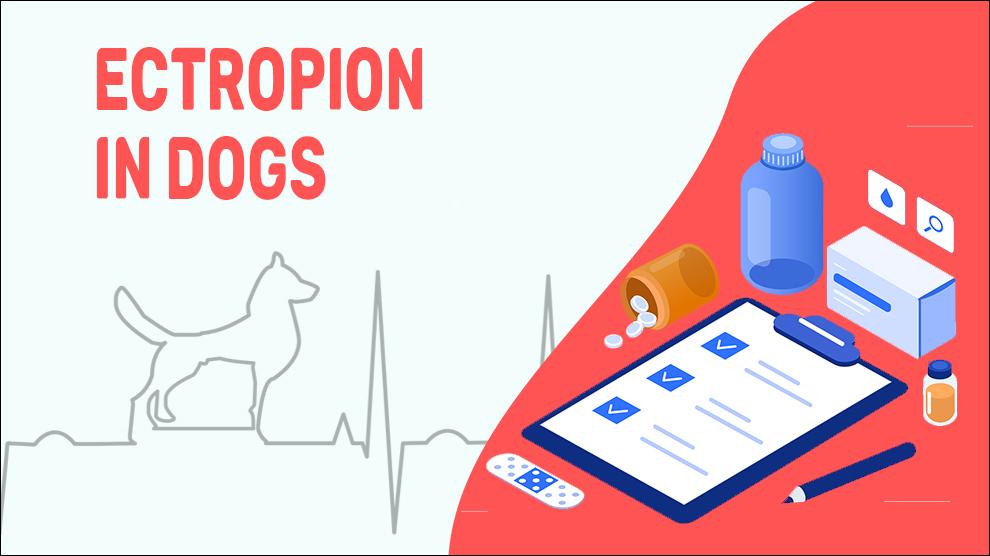Ectropion is an eversion of eyelids in which the lower eyelid droops or rolls outward resulting in a droopy or saggy appearance and exposing the delicate bulbar conjunctiva or mucous membrane that is not meant to be exposed in nature.
This may result from neurologic, traumatic, postoperative, and cicatricial causes. This is also a common condition in breeds with palpebral fissures and eyelids that are disproportionate in length and size. In a few large breeds of dogs, the lower eyelid laxity may vary with the age and fitness of the animal.
Entropion is opposite of ectropion. Entropion is a malposition that occurs when the eyelid margin rolls inward, causing the eyelid skin and eyelashes to touch the eyeball. This may occur at the time of squeezing or blinking the eyelids or all the time even when the eyelids are open.
Meanwhile, trichiasis is a misalignment of eyelashes with posterior misdirection that rub against the eyeball, in a dog that does not have entropion. Entropion usually leads to ocular surface discomfort and irritation; this may damage the cornea and inflammation or scarring of the conjunctiva.
Dogs that are unable completely close their eyes are at risk of evaporation of the tear film, corneal exposure, corneal ulceration, chronic keratitis, conjunctivitis, and keratopathy.
Symptoms Of Ectropion
- Rolling outward or sagging lower eyelid, exposing tissue below the eyeball
- Unable to fully close their eyelids
- Mucoid discharge along the eyelids
- Burning or pain in one or both eyes
- Watery or dry eyes
- Recurring Redness In Eyes or bacterial conjunctivitis
- Corneal ulceration
- Red, irritated eyes
- Light sensitivity
Treatment Options For Ectropion
The objective of Ectropion treatment is two-fold: to improve eyelid function and prevent further corneal exposure.
Treatment can be divided into two modalities- medical and surgical.
Medical treatment:
- Allergy medications: Anti-inflammatory (prednisolone or dexamethasone) or antihistamine medications.
- Antibiotics: For the application of the appropriate antibiotic treatment, an antibiogram should be performed (gentamicin, neomycin, Terramycin)
- Antibiotics such as amoxicillin, chloramphenicol, gentamicin, tobramycin, ciprofloxacin, oxytetracycline, etc.
- Eye pain and spasm- ophthalmic atropine ointment or drops.
Surgical procedure: This can be static or dynamic. The purpose is to reestablish eyelid coverage or eyelid function.
The reconstruction method and choice of treatment will depend on the etiology as well as the severity of ectropion, age, and overall health of the dog.
Sometimes, immunosuppressive therapy (medications that suppress the immune system) with corticosteroids may be necessary.
Home Remedies For Ectropion
- Supplementing for healthy eyes - help your dog have healthy ocular hygiene with supplements
- Use physiological saline or a commercial eye cleansing agent - (such as Eye Scrub) or lactated Ringer’s solution
- Apply warm compresses for 5 to 15 minutes, 3 to 4 times daily, avoiding surfaces of the eyes
- Apply cooled chamomile tea to a cotton ball and clean the affected eye
Prevention Of Ectropion
Ectropion due to the hereditary abnormality can be prevented by stopping the breeding of affected dogs so that the risk of passing the condition on to the next generation is averted.
Metabolic-related infections: try to prevent or avoid metabolic issues and infections.
Food-related: consult with the vet for any specialized hypoallergenic diets.
Affected Breeds Of Ectropion
Basset Hound, Bloodhound, Boxer, Cocker Spaniel, Bulldog, Saint Bernard, Great Dane, Labrador Retriever, Shih Tzu, Mastiff, Chow Chow, Newfoundland
Additional Facts For Ectropion
1. Causes:
Congenital ectropion:
Some breeds of dogs are genetically predisposed such as hound breeds, spaniel breeds, and bully breeds.
Acquired ectropion
Infection:
- Viral and bacterial infections
- Mastoiditis
- Fungal (Mucormycosis)
- Immunocompromised dogs
Metabolic:
- Hypothyroidism
- Diabetes mellitus
- Hypertension
Trauma:
- Facial nerve paralysis
- Birth trauma
- Temporal bone fracture, Fractures to the skull base
- Facial injuries
Tumour:
- Leukemia
- Carcinoma (primary or metastatic)
- Facial nerve tumor
- Cholesteatoma
- Meningioma
- Haemangioblastoma
- Acoustic neuroma
- Sarcoma
Toxic:
- Arsenic
- Thalidomide
- Alcohol excess
- Carbon monoxide
2. Mortality: There is no mortality due to this condition documented yet
3. Diagnosis:
- Tonometry, slit lamp, and fundoscopy
- Inner eye gonioscopy
- Biomicroscope
- conjunctival cytology or biopsy
- Intraocular pressure testing
- Corneal stain testing
4. Prognosis:
Ectropion isn't a lethal condition, but it can ultimately lead to eye problems. Discuss with your vet to figure out the underlying cause.
Depending on the cause, ectropion can be treated with either medication to keep the eyes moisturized or surgery.
When To See A Vet
Contact your vet right away, if you notice any of the following:
- Rolling outward or sagging lower eyelid, exposing tissue below the eyeball
- Unable to fully close their eyelids
- Mucoid discharge along the eyelids
Food Suggestions For Ectropion
The diet should be included foods containing vitamins A, C, omega 3s, zinc, carotenoids, beta-carotene, lycopene, and antioxidants.
- Omega-3 oily fishes such as salmon, tuna, cod, etc.
- Leafy greens such as spinach, kale, watercress, etc.
- Nonmeat/plant protein sources such as nuts, Lentils, Beans, Eggs, etc.
- Citrus fruits or juices, Sweet potatoes, tomatoes, pumpkin.
- Zinc foods such as Pork, tuna, and Oysters.
- Blueberries, Broccoli, cabbage, carrots, etc.
Conclusion
The cause of the Ectropion determines the prognosis.
Proper treatment of Infectious causes of Ectropion do extremely well and is not at risk of developing problems in the future.
Congenital abnormality caused by Ectropion can be surgically corrected, and the prognosis is excellent.
Benign eyelid tumors in dogs can be removed surgically with a good prognosis.

















